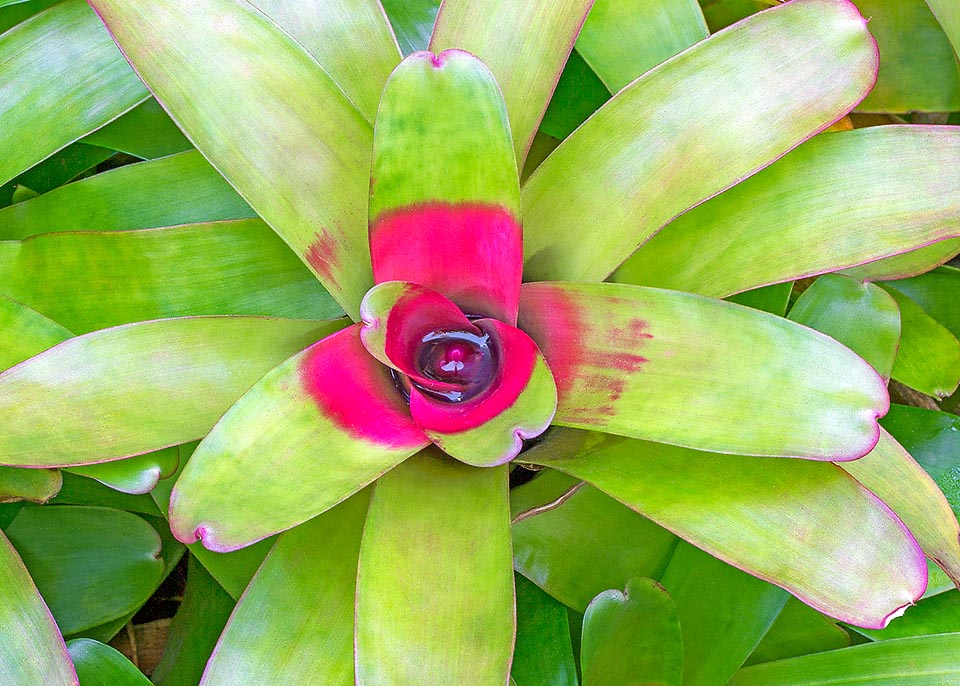Family : Bromeliaceae

Text © Pietro Puccio

English translation by Mario Beltramini
The species is native to Brazil (Espírito Santo and Rio de Janeiro) where it grows on the trees of the humid forest (Mata Atlântica).
The genus is honoured to the German botanist Eduard August von Regel (1815-1892) with the addition of the Greek prefix “νέος” (néos) = new, to distinguish it from the pre-existing genus Regelia of the family of the Myrtaceae; the name of the species is the Latin adjective “compactus, a, um” = compact.
Common names: bromélia (Brazil).
The Neoregelia compacta (Mez) L.B.Sm. (1939) is a monocarpic herbaceous evergreen species, acaulescent, epiphytic, with long creeping stolons, 25-30 cm tall, and 30-40 cm broad, formed by an infundibuliform compact rosette of leave that form a central cavity where gathers the rain water. Oblong leaves with rounded mucronate apex and entire or slightly thorny margin, 20-25 cm long and 3-3,5 cm broad, of glossy pale green colour, coriaceous; at the time of the blooming the leaves surrounding the cavity turn white red at the base. Inflorescence, on a short scape at the centre of the rosette, simple, racemose, surrounded by an involucre of bright red bracts, with rachis extremely short to arrange the flowers at the same level on the bottom of the cavity.
Flowers subtended by pink reddish floral bracts, numerous, ephemeral, that open in succession; calyx with 3 sepals united at the base of intense pink colour, 3-3,5 cm long, corolla emerging over the water level, with three petals united at the base, white below, violaceous purple at the apex, 2,5-3 cm long, with stamens inside the corolla arranged in two series of 3 and oblong inferior ovary.

Epiphyte to the humid Brazilian forests, the Neoregelia compacta makes its way among the branches with long creeping stolons. The even 40 cm broad rosettes collect at the centre the rainwater. Very cultivated, also in pot, has originated numerous varieties and hybrids. In the tropical gardens is often used in flowerbeds or as soil cover © Giuseppe Mazza
The fruits are berries with numerous seeds surrounded by a sticky jelly substance, their dispersion is favoured by the birds nourishing of the fruits. After blooming the plant stops growing, but keeps vital for long time contributing to the nourishment of the new vegetations produced at the base.
It reproduces by seed, cleaned from the sticky substance covering them, placed superficially on a draining and aerated organic loam maintained humid at the temperature of 24-26 °C, by division of tufted plants and through the new plants produced at the base that can be detached when they have reached a dimension equal at least to one third of that of the mother plant.
Species standing among the most cultivated of the genus, together with the numerous selected varieties and the hybrids, utilizable as epiphyte, on the branches or along the trunks of the trees, or terrestrial, in flowerbeds or as soil cover, in the tropical, subtropical and marginally warm temperate mildest regions.
It bears the full sun, were it gets a more intense colouration, as well as the shade, the high temperatures and short periods of drought, ensuring of the constant presence of non calcareous water at the centre of the rosette. It is often cultivated in pot, utilizing a porous and draining substratum, for the decoration of greenhouses, luminous inner spaces and terraria, with lowest winter temperatures not under the 15 °C and high humidity, 65-80 %, if less, recourse may be done to nebulizations in the morning with non calcareous water at room temperature in order not to stain the leaves.
Synonyms: Nidularium compactum Mez (1891); Aregelia compacta (Mez) Mez (1896).
